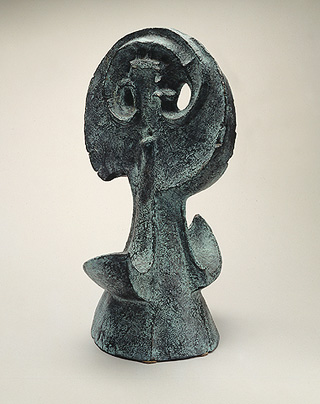 |

|
It's a Bird! And Another Bird! Answer Man Takes Closer Look at Imposing Sculpture. By John Kelly On Loughboro Road NW, near Lowell Street, there is an imposing house which I take to be an ambassador's residence. Just behind the low iron fence is a large bronze statue of -- something. My husband calls it "the angry hen." I suspect it is meant to be an eagle or perhaps some mythical monster. What is it? V. E. Coates, Washington It is a bird with two faces. Or, more accurately, "Pájaro de Dos Caras," the name given to it by Juan Soriano, the Mexican artist who sculpted it in 1993. The statue was unveiled at the Mexican ambassador's residence March 15, 2008. "Depending on where you're looking at it from, it gives you two different perspectives of basically the same animal," said embassy spokesman Ricardo Alday. "From the street, it shows one of the faces of the bird. When you look at it coming out of the residence, it gives you a totally different perspective." The bronze sculpture is about 12 feet high and weighs more than a ton. It's a duplicate of one outside the Palacio de Bellas Artes in Mexico City. Soriano, who died in 2006 at the age of 85, was one of Mexico's leading modern artists. He was born in Guadalajara in 1920 and moved to Mexico City in 1935. There, he became part of the Mexican School, a group of artists and intellectuals that included Frida Kahlo, Diego Rivera and Octavio Paz. "He was somebody who was very curious," Ricardo said. "He devoted a lot of time and work to researching and expressing his thoughts on indigenous cultures in Mexico." Known mainly for his paintings, which drew on such sources as Cubism, Surrealism and German Expressionism, Soriano also produced nearly two dozen monumental sculptures. His 1989 massive "Paloma" ("Dove") stands at the entrance to the MARCO museum in Monterrey. When he died, he left several giant sculptures unfinished. "He was sort of consumed at the end of his life doing this kind of art," Ricardo said. "He had a particular interest in birds." Paz wrote several essays about Soriano and his work, once describing him as "a boy of 1,000 years, an old man of 20." Soriano's wake was held outside Mexico City's Palace of Fine Arts to the strains of a mariachi band. Don't blame Virginia's DMV. Answer Man contacted Melanie Stokes there, and she said they just put out the designs that are given to them by the various groups that have commemorative plates. "They provide the artwork and everything," Melanie said. Apparently, these particular plates were put in motion and manufactured before it was decided to name the center after Steven Udvar-Hazy. He's the Hungarian-born entrepreneur who made his billions in the aircraft leasing business and in 2000 donated $66 million to build the Smithsonian aviation museum. It opened in 2003. "Whenever we hear from them, we'll be happy to update" the plates, Melanie said, adding that they'll even recycle the old, unused plates. Well, Smithsonian? "We have never had any requests to change it," the museum's Claire Brown told Answer Man. Consider this a request. Superintendent Alexandria reader Richard R. Palmer wrote to point out that Loren B.T. Johnson, the psychiatrist who built the garden at 16th and Florida NW that Answer Man wrote about last week, was never the superintendent of St. Elizabeths Hospital. "William Alanson White was the superintendent from 1904 to 1937 that would have been the period of the likely career of Johnson," Richard wrote. Johnson did work at St. E's, as a physician and the director of the outpatient department. He also did a stint at Garfield Hospital, where he dedicated a building in honor of his late first wife.
|
| |
|

